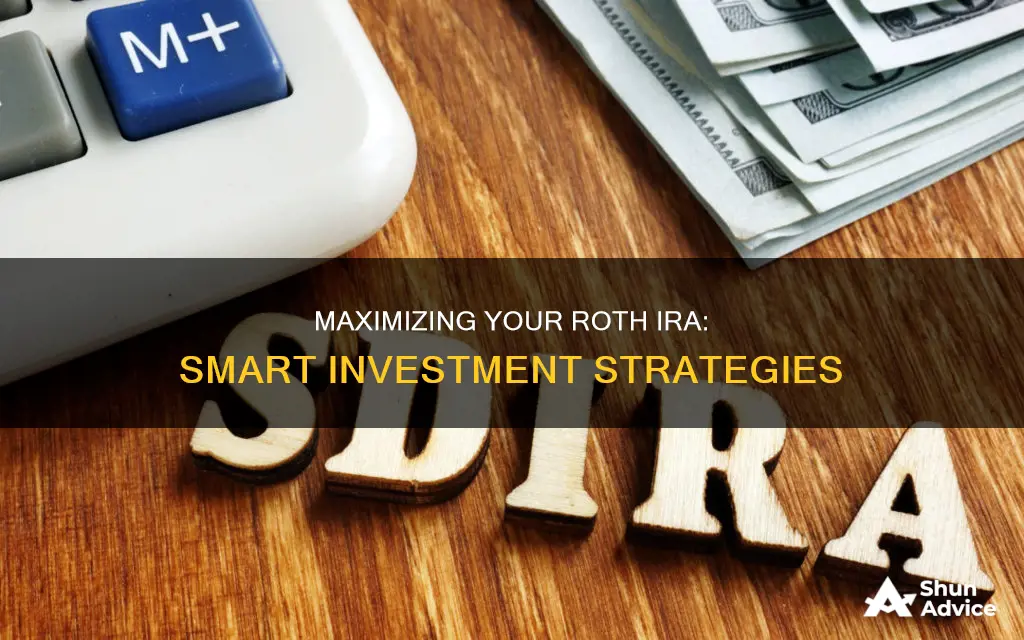
A Roth IRA is a special retirement account that allows you to pay taxes on contributions and then withdraw money tax-free. Contributions to these accounts aren't tax-deductible, but money grows tax-free and can be withdrawn without paying taxes after age 59½.
When choosing investments, it's important to consider how comfortable you are with risk and your tolerance for it. Generally, stocks are considered riskier but offer higher returns, while bonds are safer but yield lower returns.
- U.S. stock index funds: These funds track the performance of a specific stock index, like the S&P 500, and provide a well-diversified portfolio with reduced risk and potential for solid gains.
- U.S. bond index funds: Bond funds help reduce the overall risk of your portfolio over time. While they may not perform as well as stocks, they provide stable and secure income with lower returns.
- Global stock index funds: These funds invest in stocks from around the world, providing exposure to international markets and companies.
- Dividend stock funds: These funds invest in companies that pay dividends, which can be reinvested to grow your portfolio. Dividends are not subject to tax in a Roth IRA.
- Target-date funds: These funds automatically adjust your asset allocation over time as you approach retirement, making them a hands-off option for those who don't want to actively manage their portfolio.
| Characteristics | Values |
|---|---|
| Tax efficiency | Funds grow without being taxed |
| Tax-free withdrawals | If you are 59 1/2 years old and your Roth IRA has been open for at least five years |
| Tax-free income in retirement | No required minimum distribution |
| Eligibility | Income thresholds restrict eligibility to target benefits towards the middle class |
| Investment options | Stocks, bonds, mutual funds, exchange-traded funds (ETFs), real estate investment trusts (REITs), target-date funds, robo-advisors, cryptocurrencies |
| Investment strategy | Long-term, buy-and-hold approach; focus on diversification, low fees, and risk management |
| Risk tolerance | Consider age, time horizon, and financial situation to determine appropriate level of risk |
What You'll Learn

U.S. Stock Index Funds
The S&P 500 index fund is a popular choice for U.S. stock index funds. It includes a diverse range of 500 large U.S. companies, such as Amazon, Apple, and Microsoft, and has historically performed well, with average annual returns of about 10%. The Schwab S&P 500 Index Fund, for example, has an expense ratio of only 0.02%, making it a cost-effective option.
Another option is to invest in a total stock market index fund, which provides exposure to the entire U.S. equity market, including large-cap, mid-cap, and small-cap stocks. Small-cap stocks, in particular, have high growth potential over time and can lead to high returns, although they are riskier.
When investing in U.S. stock index funds, it is important to consider your risk tolerance and investment goals. While these funds are generally stable, there is still some degree of risk involved, and the potential for higher returns may be accompanied by higher volatility. It is also essential to keep in mind the tax implications of your investments and how they fit into your long-term financial strategy.
Special Purpose Fund: A Guide to Investing Wisely
You may want to see also

U.S. Bond Index Funds
A low-cost U.S. Bond Index Fund that tracks a U.S. aggregate bond index can provide broad exposure to this less risky asset class. An aggregate bond index typically includes exposure to Treasurys, corporate bonds, and other types of debt securities.
For a long-term retirement portfolio, most investors want exposure to both stocks and bonds. This can be achieved through a single stock index fund and a single bond index fund, or through a "balanced fund", which holds both stocks and bonds.
The exact proportion of stocks to bonds in your portfolio will depend on five primary factors:
- How close you are to retirement age
- How long you expect to live
- How risk-averse you are
- Your financial goals
- How much you prioritise growth through stocks versus income from bonds
Based on performance data that in some cases goes back to 1820, a traditional view is that a 60/40 portfolio (60% stocks and 40% bonds) will satisfy the needs of most investors. Many investors use this 60/40 strategy as a starting point and then boost the proportion of bonds to stocks as they advance into retirement.
Another popular yardstick is the "100 minus your age" rule, which is applied throughout life. This means that a 30-year-old should hold 70% stocks and 30% bonds, and by age 40, they should have a 60/40 portfolio.
However, many financial experts, including Warren Buffett, recommend sticking with a higher percentage of stocks, as people are living longer and are therefore more likely to outlive their retirement savings unless their stock weighting is high enough to keep them growing well into retirement.
A broad-based U.S. bond or fixed-income fund is generally less susceptible to loss of value in the long run than an equity fund. However, bond funds don't provide the same growth potential, which means generally lower returns. They can be useful tools for risk-averse investors and as part of a portfolio diversification strategy.
Robinhood's S&P 500 Index Fund: A Step-by-Step Investment Guide
You may want to see also

Global Stock Index Funds
When choosing a global stock index fund, look for funds that track indices such as the MSCI ACWI (Morgan Stanley Capital International All Country World Index) Ex-US or the EAFE (Europe, Australasia, Far East) Index. These funds provide broad geographical diversification at a relatively low cost, making them an attractive option for investors looking to minimise fees.
When adding a global stock index fund to your portfolio, it's important to consider your overall asset allocation and risk tolerance. Global stock index funds tend to be more volatile than US stock or bond index funds, so they may be more suitable for investors with a longer time horizon and a higher risk appetite.
It's also worth noting that while global stock index funds can provide diversification benefits, they may not be necessary for all investors. A well-diversified portfolio can be achieved by investing in a mix of US stock and bond index funds, which provide exposure to different asset classes and market sectors. Ultimately, the decision to include global stock index funds in your Roth IRA should be based on your investment goals, risk tolerance, and time horizon.
Real Estate Fund Investment: A Beginner's Guide to Success
You may want to see also

Dividend Stock Funds
If you are building a Roth IRA to save for retirement, you should design a portfolio using a long-term, buy-and-hold approach. A strong portfolio will be diversified across different asset classes, such as stocks and bonds, and across market sectors.
You can choose either a total market fund or an S&P 500 index fund. U.S. total market funds attempt to replicate the performance of the entire U.S. equity market, including small- and mid-cap stocks, whereas an S&P 500 index fund focuses entirely on large caps. Small- and mid-cap stocks may exhibit higher volatility but produce higher returns.
There is strong evidence that index funds, which attempt to mimic the performance of an index by passively investing in the securities included in the index, generally outperform actively managed funds over the long term. One reason for that outperformance is the difference in costs, such as management fees.
A passively managed U.S. stock index fund, when held for the long term, has the potential to benefit from the growth of the U.S. equity market over time. Such a strategy may help investors avoid the significant trading costs of actively managed funds, whose managers try to time the short-term ups and downs of the market.
A broad-based U.S. stock index fund carries a certain degree of risk but provides fairly strong growth opportunities. It's foundational for a long-term retirement account. However, those with a very low-risk tolerance or who are approaching or entering retirement may want to trim their risk of volatility by boosting their portfolio's allocation to income-oriented assets such as bonds.
Mirae Asset India Equity Fund: Smart Investment Strategies
You may want to see also

Target-Date Funds
These funds automatically adjust their asset mix over time, reducing the proportion of riskier assets like stocks and increasing safer options like bonds as the target date approaches. This makes them an attractive option for those who want a more conservative investment strategy as they approach retirement. The automatic rebalancing feature also means that investors don't need to worry about adjusting their portfolio as their risk tolerance changes over time.
Some investors may prefer to have more control over their asset allocation and may opt for a more actively managed portfolio. However, target-date funds offer a simple, low-maintenance solution for those who want a more passive investment strategy.
Vanguard, for example, offers a range of target retirement funds with a minimum investment of $1,000, providing access to thousands of U.S. and international stocks and bonds. Their funds have an average expense ratio of 0.08%, which is significantly lower than the industry average for comparable target-date funds.
Hedge Fund Managers: Why Shun Sustainable Investing?
You may want to see also
Frequently asked questions
A Roth IRA is a special individual retirement account (IRA) in which you pay taxes on contributions, and then all future withdrawals are tax-free.
The best way to grow money in a Roth IRA is by investing in assets that will appreciate over time and that can generate an income, such as bonds and dividend stocks.
While there is no one-size-fits-all option, look for assets that offer diversification, feature low fees and provide the right level of risk. Some examples include U.S. stock index funds, U.S. bond index funds, global stock index funds, and dividend stock funds.
Yes, you can choose your own investments in a Roth IRA, and most brokerage firms offer a wide variety of investment options.
In most cases, you must be 18 years old to open your Roth IRA.







